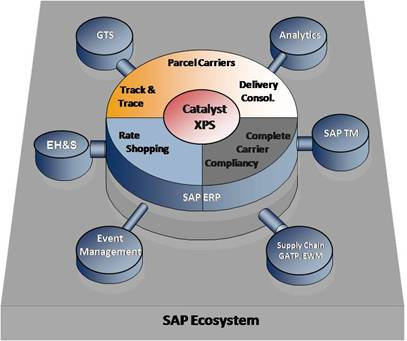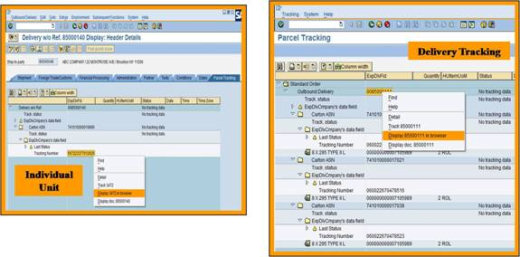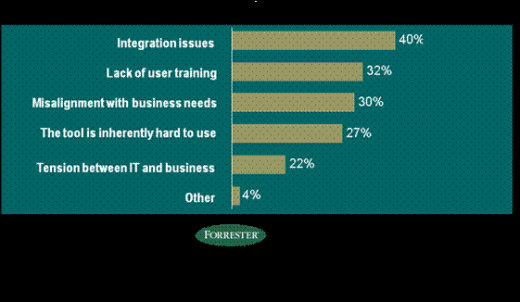| INFORMATION: Free information is available from CATALYST on the subject in this story. Click here to request a copy |
Executive Summary:
In todays environment, transportation and shipping are not standalone functions. On the contrary, they are more often a tightly integrated aspect of the complete end-to-end supply chain. The options that have been available to companies for processing parcel shipping transactions from within SAP environment, whether it is standalone carrier-supplied software, a third-party application or a custom application developed internally, tend to have similar issues they rely on middleware and arent fully integrated into SAP.
The result of this gap in capability is increased shipping costs and more time required to ensure that the shipper is compliant with the ever-changing aspects of the various small parcel shippers everything from rate changes to label format changes. This whitepaper will discuss a tool that is available to help bridge that gap. Catalyst XPS integrates information from all the major small parcel carriers into one view, fully integrated with SAP. Customers can save money and improve customer service, without creating an additional maintenance burden on their internal IT team.
The Small Parcel Carrier Challenge
Small parcel traditionally has been very different from LTL carriers or Truckload carriers. Currently, there is no solution that is fully integrated with SAP to give you the convenience of a singular point of access to evaluate and utilize any of the major small parcel carriers.
Further complicating how shippers work with small parcel carriers is the fact they are not all standardized when it comes to things such as rates and labels. Essentially, the carriers make the rules. They determine how the labels look, what the file format is, what the rate structure is. Then, they change these things constantly, so keeping up with them, across multiple carriers can be challenging. Couple this with constantly changing rules and service levels and it is highly complex and difficult to implement the parameters for an algorithm yourself.
Another challenge is the ability to track and trace the status of your packages. Very rarely will the carriers be willing to provide you with a standard tool for tracking delivery status. More often than not, you will need to rely on a third-party company or develop a web interface internally that enables you to collect the information from these carriers and update your existing systems. Carriers continue to change their Websites regularly, requiring vigilant maintenance to ensure your internal software is pulling the right data from each carriers Website.
What Are Your Alternatives?
As part of the SAP installed base, what alternatives do you have with regards to the challenges you face with small parcel carriers? We can broadly divide these into three categories:
o Stand-Alone Carrier Supplied Software
o Non-SAP Third-Party Shipping Software
o Custom Internal Development
Stand-Alone Carrier Supplied Software
This includes standard software and hardware that are provided by the carriers at no cost to you. If you are using stand-alone carrier supplied software, chances are you have segregated, designated areas for each carrier. You can only process shipments for a particular carrier on a particular machine, since the software has its own interface to communicate with SAP or your warehouse management system. For example, FedEx may accept text file interfaces, where with UPS WorldShip you have a file you have to upload. None of these options are robust and none of them give you real-time capabilities.
The advantage to using stand-alone carrier supplied software is that you know the software will always be compliant with the carrier and can keep up with the changes, new services and label formats. Another advantage is the fact it is provided at no cost to you. So, if for example, you want to ship UPS, you can call your UPS rep and they will install and maintain the system within your environment. There is little required from your IT department and if anything happens to the machine or software, the carrier bears the responsibility of its maintenance.
A major drawback is the fact that this software is, indeed, standalone. The software from each of these shippers isnt talking to each other, so you are not able to get a comprehensive view of something as simple as rate comparisons. Another disadvantage is the time invested in training employees on terminals. Its not as though they are trained on just one system that integrates all the carrier information. Multiple carriers require that employees are trained on multiple systems and you will have to manage multiple instances of the same software when it comes to performing manifest operations and end-of-day transmissions.
For example, lets say you are a large shipper with 50 UPS stations. Under this model, you will have to perform 50 end-of-day transmissions so UPS has the correct data. Many companies are moving away from this option and are looking for a singular, more efficient system that can deliver real-time data within their existing SAP system.
Non-SAP Third-Party Shipping Software
There are plenty of these on the market today. Like stand-alone carrier supplied software, there are advantages and disadvantages to this approach. In this scenario, the third party software sits between the carrier engines and the SAP system via some sort of middleware, such as WebMethods, NetWeaver, XI or possibly an older technology like plain and simple RFCs.

Figure 1 Third-Party Shipping Software
Figure 1 shows how your transaction would look in this approach. As you can see, there are many steps and limitations involved with this architecture. Couple this with the fact that IT will have to maintain the non-SAP software, adding to the cost and time involved when it comes to installation and maintenance. Typically the core competencies of these software vendors is focused on the carriers, not necessarily SAP. Due to the complexity and the lack of SAP-specific focus, these types of systems have the potential for data synchronization and data discrepancy issues.
For example, SAP sends shipping data down for a package as being sent via FedEx Overnight. When this arrives at the shipping station, the user realizes that the destination isnt served by FedEx Overnight. So, they change the service at the shipping station to another carrier. Often, the change made here will not make it back to SAP. You will have to reconcile data from two different places to ensure you have an accurate picture of your freight spending.
Another disadvantage is that, like carrier-provided software, you are still relying on middleware to communicate between the third party engine and SAP. There are some risks inherent here when it comes to licensing between the middleware and the carrier.
A final disadvantage is the burden these systems can place on your internal IT team. They will be the ones to work with the vendor to install and maintain the system or have the customizations that are essential to accommodate ever-changing industry rules and demands. If you are relying on a non-SAP system, you constantly have to pay to be in touch with the vendor or you have to get your IT staff trained on a non-SAP technology so these updates can be done in-house.
Even after all this, the warehouse is still dealing with accessing two different systems. They will access SAP for picking and packing operations, then the third party interface for shipping.
While there are some drawbacks, there are some advantages to Third-Party Shipping Software compared to the carrier provided software approach. Typically, these software products are feature-rich and you can use on instance globally for all of your warehouses. These products tend to be more integrated with SAP compared to carrier software.
Internal Custom Development
There is a third option developing a custom solution internally. This is ideal if you have a strong SAP internal staff that has the expertise to leverage the SAP ecosystem and the SAP tools to integrate the solution with the carriers.
The drawback with this approach is that you will still end up using some sort of middleware. So, from SAP to rating engine, you will use either XI or Business Connector, or even NetWeaver Web Services. A second drawback is the considerable development work involved in integrating carriers and each carrier is different.
Development teams also have to be vigilant about communicating with carriers to ensure they are aware of the latest rules and service offerings to make the right changes in their system.
Catalyst XPS A New Option For Cross-Carrier Packing
Catalyst XPS is an option for customers who are looking for the benefits and all of the advantages of the other approaches, but in a solution that is fully integrated with SAP. Catalyst XPS can also be deployed in a quick timeframe, averaging about 32 days from blueprint to go live. It is also a solution with a global footprint. Catalyst has implemented XPS in countries outside of the U.S. including Ireland, Sweden and Germany.
Catalyst XPS Advantages
Always compliant with carriers Catalyst XPS eliminates the need for internal teams to constantly be in contact with carriers to keep up with the latest changes in rates, services or formats.
Low Burden of Maintenance There is no installation, no maintenance, no CD to run on a Microsoft Server. All of these requirements go away.
No Middleware Catalyst XPS requires no middleware to sit between SAP and the application.
Leverages Your Existing SAP Ecosystem This is a built-in solution, not a bolt-on and resides completely within your SAP environment. See Figure 2
Complete integrated visibility across all carriers One application gives you visibility into rates for all carriers, access to necessary forms and real-time track and trace visibility from within SAP sales order or SAP sales delivery.
Figure 2 Catalyst XPS is a Built In not a Bolt On
Key Features of Catalyst XPS
Rate Shopping
Catalyst XPS has a simulation mode allowing you to perform rate shopping, providing the data you need to negotiate new rates with carriers. You can take historical data and rate it against the new carrier rate to determine how much your savings will be. When you are shipping, XPS can also assign the cheapest carrier for each shipment as a default setting. In this instance, XPS does this in the background and the window showing all the delivery rate options across the carriers will never show to the user. See Figure 3

Figure 3 Rate Shopping Screen
Delivery Consolidation
If you are using standard SAP, the only way to consolidate multiple deliveries easily is to utilize SAP Shipments. If you dont have SAP Shipments then should you have multiple deliveries going to the same place, via the same carrier and service, you will end up packing them and shipping them individually. A small parcel carrier charges you per package, so even though they are going to the same place, you are not optimizing your freight savings. XPS allows you to pack multiple deliveries together whether in a single or multiple HU. You can then ship them as one consolidated shipment without having to use SAP shipment.
Track and Trace
XPS is very tightly integrated with the XSI module, enabling you to have real-time visibility right from the SAP sales order or SAP delivery screen. You can right click on a tracking number and the system will take you to the carrier Website with all the information automatically filled in. Customer service will never have to copy a tracking number from SAP and manually track the status from the carriers Website. Real-time tracking can be performed from your standard SAP screen. This information can help you know when a package has been delivered or if it was delivered late, allowing you to file a claim with a carrier or proactively alert your customer that the shipment is late. See Figure 4.

Figure 4 Track and Trace Screens
An Integrated Solution, Saving You Time and Money
While there are several options for companies when it comes to packing and shipping, Catalyst XPS is the only option that resides within your SAP ecosystem and requires no middleware. It is also completely compliant with the carriers at all times, saving IT and shipping time and headaches trying to keep up with the many changes the carriers initiate.
Catalyst XPS and SAP EWM
Catalyst XPS removes the need for additional databases and additional IT support resources for non-SAP systems. Catalyst XPS avoids the need for developing and supporting specific middleware between SAP and the third-party carrier systems because it creates a direct communication between SAP and the carrier systems.
Additional features of XPS integrated with EWM
Implementation of XPS for an SCM EWM warehouse will include both ERP/ECC and EWM components.
ERP/ECC system will be used for Planning and Monitoring. Planning and Monitoring functions will reside in ERP/ECC system
Execution functions will be available in ERP/ECC system for non-EWM shipping locations
Execution of parcel and LTL shipping will occur from SAP SCM EWM
Shipping transaction details (rate, tracking number, accessorial charges, etc.) will interface from SCM EWM to ERP/ECC
Tracking status updates will occur in the ERP/ECC system
Additional Integration Benefits
With XPS, you have integrated manual and SAP shipping operations into one system that allows you to perform SAP shipments or non-SAP deliveries. There are features that will help optimize freight savings, such as rate shopping, delivery consolidation and freight and service auditing. These give you full control to make sure you are paying the right amount with the carriers and are able to be proactive in your customer service.
We also have the communication tools with the hardware built in. So, if you have a scale attached to a shipping station, or label printers and scanners attached to the station, XPS will read the information without middleware. You dont have to maintain your printers in SAP either. These can be locally attached printers or scales, so the data management in SAP is minimal and your IT team and data management teams are not getting additional responsibilities with XPS.
On the soft benefits side, all the information for deliveries is now available in one single instance. Customer service and sales never have to call a warehouse to find out all the tracking numbers or different freight charges. They can now go directly to SAP standard screens to get all this information in real time.
According to Forrester, one of the biggest items that reduces ROI is the effort required for integration. If you have non-SAP systems, you are spending a lot of time and effort building integration between the non-SAP and SAP systems. With XPS there is no integration required since XPS resides in SAP. This means you dont need any other tools to integrate with the rating engine and you are able to experience the cost optimization benefits. See Figure 5

Figure 5
In terms of end user adoption, XPS can be used with standard SAP so end users never realize they are using another module. End users need no additional training so the learning curve is small.
In conclusion, transportation and shipping are not stand-alone functions. In todays environment, they are typically tightly integrated into the supply chain process. Now SAP customers have the option to leverage a cross-carrier small parcel shipping tool within their standard SAP environment as part of their global process, regardless of the carrier, origin or whether it is domestic or international. Catalyst XPS provides a new option for SAP customers who want to reduce the cost and complexity in their shipping without the hassle of middleware. For more information, visit www.catalystwms.com for additional information on the solution.
About Catalyst
Catalyst, a services business of CDC Global Services, is a highly specialized SAP services partner with special gold consulting partner designation within the SAP consulting program. Catalyst is a leader in the design and implementation of SAP Supply Chain Management (SAP SCM) components. We are specialists in services and applications for SAP Warehouse Management (SAP WM), SAP Extended Warehouse Management (SAP EWM) SAP Task and Resource Management (SAP TRM) and SAP Transportation Management (SAP TM). In addition Catalyst has developed several applications, such as Yard Management Drag and Drop and Cross Carrier Parcel Integration, which enhance the usability and functionality of SAP Supply Chain Management. For more information, please visit www.catalystwms.com
About CDC Global Services
CDC Global Services provides IT consulting services, including platform-specific services for Microsoft and SAP, as well as project management, staff augmentation, managed-help desk solutions and a full range of outsourced service offerings. It can also provide hardware for data collection and RFID, through partnerships with some of the industrys most reputable vendors. CDC Global Services embraces a customer-first approach being able to draw upon a wide range of expert resources to address each customers unique business needs, while keeping their best interest as a top priority. CDC Global Services customers benefit from streamlined vendor management and the ability to control project costs, while being able to access the right IT resources through a singular point of contact. For more information, please visit www.cdcglobalservices.com.
| INFORMATION: Free information is available from CATALYST on the subject in this story. Click here to request a copy |

Add a Comment
No messages on this article yet